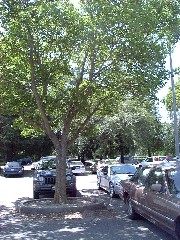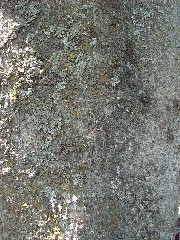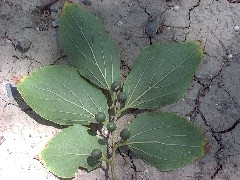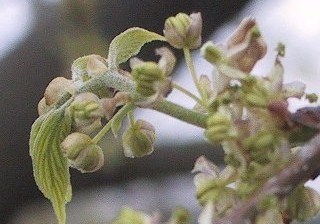Chinese Hackberry
Scientific name: Celtis sinensisFamily: Cannabaceae
Pronunciation: SELL-tiss sye-NEN-sis
More about the name here
hackberry1_audio.mp3| Podcast script
Whole Chinese Hackberry |
Bark of the Hackberry |
Leaves of Hackberry |
Flower of hackberry from http://www.botanic.jp/plants-aa/enoki.htm  |
Classification:
Angiosperm, Dicot, deciduousMore information about monocots and dicots click here.
Size:
It is a long slender tree reaching as high as 50 ft tall and 4 ft in diameter. The span of the tree is 20 to 30 feet.Identifying Features:
There are over 60 different types of Hackberry. They are now grown as ornamental trees. They are popular as city tree in greenbelt and school because they are highly drought tolerant.Bark: The bark is a light brown to silvery gray. The bark is scale like because of its coarse grained and can be easily damaged. The branches are slender, light green at first and brown as they age.
Leaves: The leaves are one to six inches long, and one to two inches wide. They are serrated, except at the base, which is acute (sharp edge). They are in an alternate leaf pattern which means each leaf occurs singly at each node. In the autumn the leaves change to a brown yellow color and begin to drop off.
Location/Habitat:
As the name indicates the tree is native to China, Japan and Korea although they are now grown all over the world. Tee Hackberry commonly live in the southern United StatesFlower/Fruit/Reproduction:
The Flowers flower in the springBuds: They are Alternate with no terminal buds.
Flowers: The flowers bloom in May, soon after the leaves.The flowers are Polygamo-monoecious meaning they have the staminate (male part) and pistillate (female part) flowers on the same plant. The male flowers are longer and fuzzy and the female flowers are greenish and rounded.
Fruit: The fruit is a fleshy drupe (drupe is a type of flower that has an outer fleshy skin which surrounds a shell with a seed inside), oblong, one-half to three-fourths of an inch long, and dark purple in color. They have slender stems and ripen in September and October. The pistil remains on branches during winter. The fruit is edible and is sweet with a pit inside.
Water/Sun Requirements:
Sun: The Hackberry needs full to partial sunlight.Water: The tree needs a moderate amount of water but can withstand partial droughts. If you water the plant it will need 15-20 gallons of water per week during the first 2 years and 15-20 gallons twice a month after that.
Special Adaptations:
It is a hardy tree that can live in most soil and climates although they do not like areas with heavy fog. They need little maintenance and are disease and pest resistance.Other Info:
It is a Deciduous tree meaning that they lose all of their leaves in the winter.They are a relatively tall tree and can help with windbreak in farms and fields. They are used in riparian planting and highway beautification. As well as being planted in parks and for ornamental landscaping. They are food for many different birds and animals. Native Americans used the fruit to flavor meat like black pepper is used today.
Eating: Many of the parts of a tree are used for food a healing purposes. The root bark can be used for treating dyspepsia, cures poor appetites, shortness of breath and swollen feet.
The Sap: The hackberry has very unique sap. Sometimes it will get all over your car or sidewalk. It is a gritty corn starch texture. The sap is made from the Asian Woolly Aphid. The aphids suck the phloem out of the tree and then the food goes through the aphid and goes out as a poop sap sugar mixture. It will get all over the side walk, and cars more info Picture of a diseased tree here.
Enokitake: The enokitake is a mushroom that grows at the base of the Chinese Hackberry tree. They are a very popular in China and Japan and are used for cooking and canning. More information here.
Photos:)
Reference Sources/Links:
BibliographyMade by Fiona P. 2007
I hope you liked it!